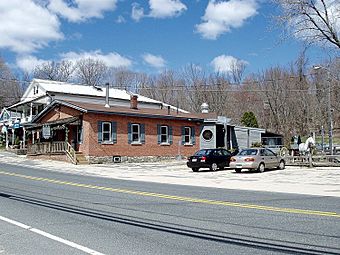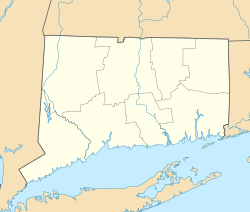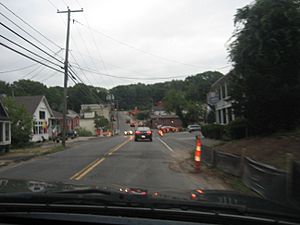South Coventry Historic District facts for kids
Quick facts for kids |
|
|
South Coventry Historic District
|
|

Bidwell Tavern
|
|
| Location | Roughly, Main St. and adjacent streets from Armstrong Rd. to Lake St. and Lake from High St. to Main, Coventry, Connecticut |
|---|---|
| Area | 250 acres (100 ha) |
| Architectural style | Greek Revival, Late Victorian, Colonial |
| NRHP reference No. | 91000482 |
| Added to NRHP | May 6, 1991 |
The South Coventry Historic District is a special area in Coventry, Connecticut. It protects the old village center of South Coventry. This village started in the early 1700s. It was once the main hub for the town. It was also a busy place for business, with factories making cloth in the 1800s. This important district was added to the National Register of Historic Places in 1991.
Contents
Discovering South Coventry's Past
South Coventry began to be settled in 1707. The town of Coventry officially became a town in 1712. In the 1700s, this area was mostly farmland. There was a grist mill on Mill Brook, which ground grain into flour.
Village Green and Early History
By 1730, the village green was set up at Lake and High Streets. This green was a training spot for local soldiers. They practiced there for the French and Indian War and the American Revolutionary War. It was a vital place for community gatherings.
Industry and Growth in the 1800s
In the 1800s, South Coventry became a small industrial center. Factories used water power from Coventry Lake Brook. This brook flows towards the Willimantic River. These mills helped the village grow and become a busy place.
Historic Buildings and Landmarks
South Coventry has many interesting old buildings. You can see several Victorian style houses. There is also a museum and the main public library. The Bidwell Tavern, a restaurant, opened way back in 1822.
A few steps away is the W.L. Wellwood General Store. It is now called "Coventry Arts and Antiques." This store was built in 1787. It might be one of the oldest general stores in the United States!
Exploring the District's Area
The historic district mainly follows Main Street (Connecticut Route 31). It stretches between Stonehouse and Armstrong Roads. It also runs along Mill Brook to the south. The district goes south on Lake Street to High Street. It also includes Wall and Prospect Streets, which are south of Mill Brook.
Size and Special Features
The district covers about 250 acres (100 hectares). It includes over 200 important historical parts. Besides the old buildings, you can still see signs of the old factories along the brook.
Honoring a Hero: Nathan Hale
The district is home to the Captain Nathan Hale Monument. This was the first major monument in the United States for the American Revolutionary War. It honors Nathan Hale, who was born in Coventry. He was a brave hero during the war.
Patriots Park
You can also find Patriots Park in the district. This park is by the lake. It used to be a summer camp run by the Salvation Army. Now it's a great place for everyone to enjoy the outdoors.




